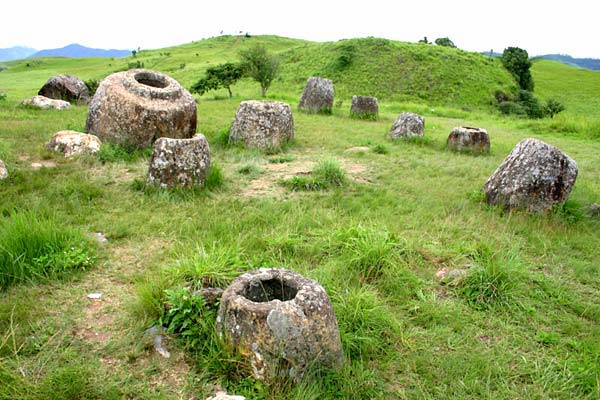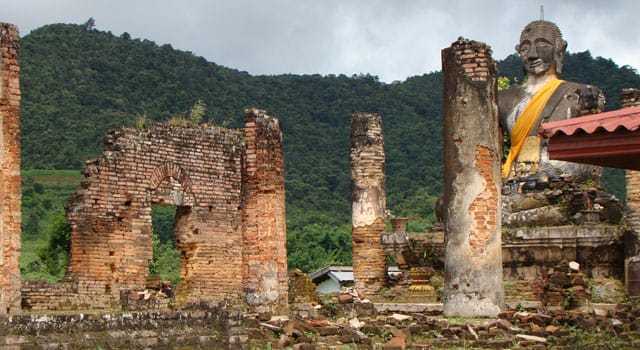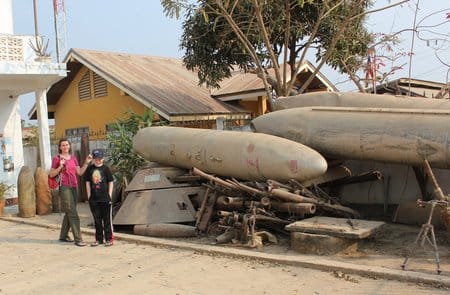Xieng Khuang province lies at the crossroads of important trade routes leading north to China, south to Thailand and east to Vietnam, and has been coveted throughout the centuries by rival Southeast Asian empires. Xieng Khuang, hemmed in by a ring of dramatic mountains, including the country’s tallest peak, Phu Bia, is best known for the treeless flatland and crater-ridden landscape of the Plain of Jars. A plateau of grassy meadows and low rolling hills situated at the centre of the province, the Plain takes its name from the clusters of chest-high funerary urns found there. For people with a very deep interest in archeology and Southeast Asian history the jars are worth the journey to Xieng Khuang, but for some tourists they are something of an anticlimax. However, their other-worldliness, against the flat barren landscape of the area, retains a certain mystique, and by choosing your guide wisely it’s possible to get a lot more out of a visit here.

As the flattest area in northern Laos, the Plain of Jars is also a natural gathering point for armies – a fact not lost on military commanders of the early kingdoms of Lane Xang, Vietnam and Siam and later the Soviet Union, France and America, the Viet Minh, the Pathet Lao and the Lao Royalists. Fought over dearly in the Second Indochina War, the region was bombed extensively between 1964 and 1973, transforming the Plain into a wasteland, which leaves a lasting impression on those who fly over it into Phonsavan.
With much of the literature of the province’s historical Phuan kingdom destroyed and many of the customs lost, Hmong culture and festivals have come to play an important role in Xieng Khuang life. Boun Phao Hmong, or the Festival of the Hmong, celebrated throughout the province in November, draws overseas Hmong back each year for an event featuring water buffalo and bull-fights. In December, Hmong New Year, a time for young Hmong to find a husband or wife, is celebrated, as is the lowland Lao festival of Boun Haw Khao, a two-day holiday in which food is offered to the dead. It has a distinctly Xieng Khuang flavour, however, with the addition of horse races, horses being especially prized by villagers who work Xieng Khuang’s far-flung fields.
Some history
Even the legends surrounding the jars reveal how thoroughly life in Xieng Khuang has been overshadowed by war, with local lore telling of how the jars were created to hold rice wine by an army of giants to celebrate a military victory. Although the identity of the civilization that built the jars remains a mystery, local folk tales telling of the arrival of the Phuan people, the lowland Lao group that still dominates the ethnic make-up of the area today, date back as far as the seventh century, when the divine Tai–Lao first ancestor Khoun Borom sent his seventh and youngest son, Chet Chuong, to rule over the Tai peoples of Xieng Khuang. Although the time frame for this version of events may be a bit premature, Xieng Khuang was nonetheless one of the earlier areas settled by Tai peoples in Laos, and by the fourteenth century, an independent Phuan principality, known as Xieng Khuang and centred on modern-day Muang Khoun, had already begun to flourish here.

While the Kingdom of Xieng Khuang had the wealth to build exquisite pagodas, it never amassed the might necessary to become a regional power. Sandwiched between the great empires lying to its east and west, Phuan kings maintained a semblance of independence over the years by offering tribute to Vietnam and Lane Xang and eventually Siam. Whatever price the royal house paid, however, it was not enough to keep Xieng Khuang from being repeatedly annexed, overrun and forcibly depopulated, beginning with the invading armies of the Vietnamese on their way back from sacking Luang Prabang in the late 1470s through to the Second Indochina War, when nearly every village in the province was obliterated.
In 1869, warrior horsemen from southern China raced across the plain, slaughtering villagers or carrying them off into captivity. These Black Flag bandits pillaged the riches of the kingdom and plundered the contents of the jars. Those that fled didn’t get far: Lao and Thai soldiers on their way to Xieng Khuang to quell the invasion rounded up the refugees and frogmarched them through the jungle to the Chao Phraya River Valley in Siam, where they became slaves to Thai lords. The tortuous march lasted over a month, with many dying along the way, lost to sickness and starvation. In two generations, Siamese armies and Chinese bandits reduced the population by three-quarters through death and forced migration. The Phuan state never recovered.

Xieng Khuang enjoyed better protection from its neighbors with the arrival of the French, who considered the province’s temperate climate – which can be downright cold by any measure for several months of the year – suitable for European settlement and plantation agriculture. The primary cash crop, however, was opium, a trade the French quickly moved to control. Muang Khoun was chosen as the French provincial capital and the devastated former royal seat of the defunct kingdom was transformed into an architectural gem of French Indochinese villas and shophouses, which might have rivalled the charm of Luang Prabang and Savannakhet had Xieng Khuang not returned to its familiar role as battleground a few decades later.
One hundred years after the carnage of the Chinese bandits, American planes wreaked destruction that was equally indiscriminate, levelling towns and forcing villagers to take to the forest, as the two sides in the Second Indochina War waged a bitter battle for control of the Plain of Jars, which represented a back door to northern Vietnam. Throughout much of the 1960s, Xieng Khuang was the site of a seesaw war, with the Royalist side led by Hmong General Vang Pao gaining the upper hand in the rainy season and the communist side launching offensives in the dry months.
Today, villages have been rebuilt and fields replanted. Many of the valley-dwelling, wet-rice farmers, as well as a majority of the townsfolk in Phonsavan, are descendants of the Phuan kingdom. In addition to the Lao, the Phuan are joined by a third lowland group, the Black Tai, and also the Khmu – a Lao Theung group who ruled the lowlands until they were forced into the hills with the arrival of the Tai groups over a thousand years ago – and a significant population of Hmong, who arrived in Laos from China in the nineteenth century and now make up roughly a third of the provincial population.






